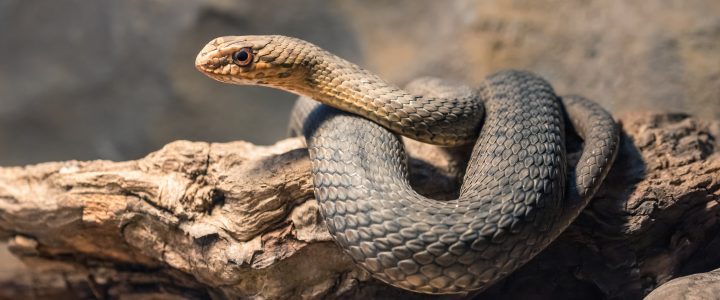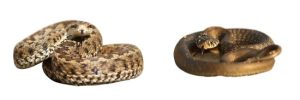 How to Tell if a Snake is Poisonous
How to Tell if a Snake is Poisonous
Snakes have long been a subject of fascination and fear for humans. While many people find them intriguing and even keep them as pets, others are terrified at the mere sight of one. One of the most common concerns when encountering a snake is whether it’s venomous or not. Identifying a poisonous snake is essential for your safety and peace of mind. This comprehensive guide will explore the key characteristics and techniques to determine if a snake is venomous.
Understanding Venomous vs. Non-Venomous Snakes
Before delving into the specific signs of a poisonous snake, it’s crucial to understand the difference between venomous and non-venomous snakes.
Venomous Snakes:
These snakes possess specialized glands and fangs that produce and inject venom into their prey. Venomous snakes use their venom to immobilize or kill their game before consuming it. While not all venomous snake bites are fatal to humans, they can cause severe harm if not treated promptly.
Non-venomous Snakes:
These snakes lack venomous glands and fangs. Instead, they rely on constriction or other means to subdue their prey. Non-venomous snakes are typically harmless to humans and serve essential ecological roles in controlling rodent populations. Some Non-Venomous snake are armed with rows of sharp teeth and the ability to squeeze the life from you so even though they are harmless, they should be still respected and kept at a distance.
Identifying Venomous Snakes: Key Characteristics
Several key characteristics can be helpful when distinguishing venomous snakes from their non-venomous counterparts.
1. Head Shape:
Venomous snakes often have a triangular or arrow-shaped head. This shape is due to the presence of venom glands and more prominent venom-injecting fangs at the front of their mouths. Non-venomous snakes typically have more rounded heads.
2. Eye Pupils:
Another noticeable difference is the shape of the pupils in the snake’s eyes. Venomous snakes typically have elliptical (vertical) pupils, similar to a cat’s eye. In contrast, non-venomous snakes usually have round pupils.
3. Tail Shape:
Venomous snakes often have shorter tails, while non-venomous snakes may have longer, tapering tails. However, this characteristic can vary among species, so it’s not a definitive indicator.
4. Coloration and Patterns:
The coloration and patterns of a snake’s skin can vary widely among species. Venomous snakes generally have more vibrant and striking coloration with patterns like bands, spots, or diamonds. Non-venomous snakes may have more muted colors and patterns that blend in with their surroundings.
5. Heat-Sensing Pits:
Some venomous snakes, such as pit vipers, possess specialized heat-sensing pits between their eyes and nostrils. These pits help them detect warm-blooded prey, giving them a distinct feature absent in non-venomous snakes.
6. Behavior:
Venomous snakes often exhibit defensive behaviors when threatened, including hissing, coiling, and striking. While non-venomous snakes can also display these behaviors, venomous snakes may be more aggressive in their defense.
Common Venomous Snakes in Different Regions
It’s essential to note that the specific types of venomous snakes vary by region. Different continents and countries have their venomous snake species, each with its unique characteristics. Here are some examples of venomous snakes commonly found in other regions:
North America:
- Eastern Diamondback Rattlesnake: Recognizable by its rattling tail and distinctive diamond-shaped
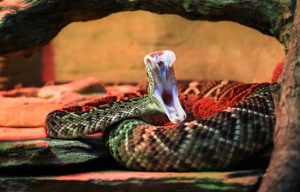 pattern. Found in the Southeastern US, Eastern Louisiana, Southern Mississippi, coastal plains of North Carolina and in Florida. It is a thick set snake and can get to 8 feet long and over 30 pounds. They are considered to be the most venomous snake in US but they move a bit slow in comparison to other snakes due to their thick body. Of course they are a rattlesnake and are identified by the diamond patterns running along its back. It also has black band covering its eyes. Another distinction is it has cat eye pupils and a large pit between the nostrils. They can be black, brown with cream diamonds or even yellow.
pattern. Found in the Southeastern US, Eastern Louisiana, Southern Mississippi, coastal plains of North Carolina and in Florida. It is a thick set snake and can get to 8 feet long and over 30 pounds. They are considered to be the most venomous snake in US but they move a bit slow in comparison to other snakes due to their thick body. Of course they are a rattlesnake and are identified by the diamond patterns running along its back. It also has black band covering its eyes. Another distinction is it has cat eye pupils and a large pit between the nostrils. They can be black, brown with cream diamonds or even yellow.
- Copperhead: Often identified by its copper-colored head and body with darker cross bands. Their coloring can be blackish or grey brown. The lower part of the body scales are enlarged are paler color. They are found in Southeastern US. they are responsible for the most bites in their area and are very dangerous.
- Cottonmouth/Water Moccasin: Known for its aggressive behavior and white mouth lining, visible when it opens its mouth. They have a thick arrow shaped head with vertical pupils which are elongated. They can be found from Southern Eastern US stretching from Texas to the Eastern Seaboard, also stemming from Florida to Missouri. They can three to four feet, sometimes longer and their bodies are thick and bulky. They are a very poisonous snake that can be found in the water.
- Western Diamondback Rattlesnake: Similar to the Eastern Diamondback but found in western regions of North America. It is also a heavy bodied snake just like the Eastern Diamond Rattle snake. It has 2 dark diagonal line on its face and dark diamond shaped patterns along its back. The tail has black and white bands just before the rattles.
Australia:
- I
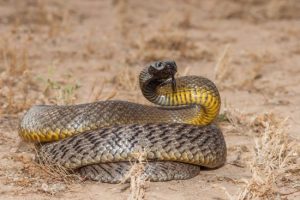 nland Taipan: Also known as the “fierce snake,” it has the most toxic venom of any snake in the world. This snake is a medium to large snake a broad build and a deep rectangular-shaped head. Their colors range from pale fawn to yellowish – brown to dark brown. The head and the neck is usually darker than the body.
nland Taipan: Also known as the “fierce snake,” it has the most toxic venom of any snake in the world. This snake is a medium to large snake a broad build and a deep rectangular-shaped head. Their colors range from pale fawn to yellowish – brown to dark brown. The head and the neck is usually darker than the body.
- Coastal Taipan: Recognizable by its slender body and coastal habitat. Found in Northern and Eastern Australia. They can be identified as light olive or reddish-brown on the front upper part of their body and the lower part of their body is paler. This snake is very dangerous and is considered the third most toxic snake in the world.
- Eastern Brown Snake: Highly venomous snake found in the Eastern and central parts of Australia. It is the second most venomous snake in the world. They have a slender build can grow up toe 2 meters long. It can pale Cream-Yellow and sometimes with orange or grey splotches.
- Death Adder: Known for its short, stocky appearance and potent venom. Commonly found in almost every state of Australia, apart from Tasmania they are generally found all around Australia.
- Mainland Tiger: Large and very poisonous snake found in South Australia and parts of Western Australia. They are recognised by their banding of black and yellow like a tiger.
Australia has the top 9 deadliest snakes in the world.
Africa:
• Black Mamba: Named for its dark coloration, it is one of Africa’s fastest and deadliest snakes. The 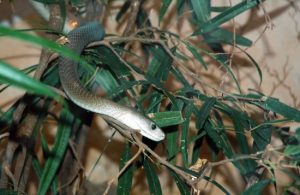 coloring can range from Gray to dark brown and the underside is lighter. The snake is not black on the outside, the black is actually inside its mouth. This snake is found in the Rocky Savannas and the lowland forest in Africa.
coloring can range from Gray to dark brown and the underside is lighter. The snake is not black on the outside, the black is actually inside its mouth. This snake is found in the Rocky Savannas and the lowland forest in Africa.
• Puff Adder: Recognizable by its thick body and distinctive pattern.The Puff Adder has distinct markings, they are very thick, medium size and grow on average to about three feet long. They are usually brown, gold and tanned. They a line between the eyes on top of the head and their pupils are slit. They have these chevron markings down the body narrowing down to being bars near the tail section. These snakes have the record for the most amount of bites in Africa and they are very poisonous.
• Cape Cobra: Known for its striking yellow or brown coloration and hood when threatened. They have also been found to be reddish black. They have the typical hood found on Cobras. They are slender snake but large in size and can grow from 1.2 m to 1.6m in length. It is most found on the ground but it has been found climbing into trees and shrubs. Once again, this is a highly venomous snake. This reptile is found Southern Africa.
Asia:
• Indian Cobra: Recognizable by its hood and distinctive markings on the back of its hood.
• 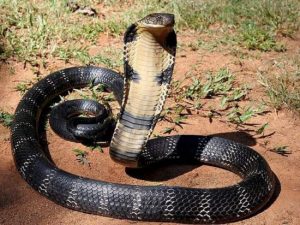 King Cobra: The world’s longest venomous snake, with a unique, intimidating appearance. The coloring is either Yellow, Green, Brown or Black with alternating chevron banding along their bodies. Their head is larger that other Cobra’s. They are generally shy and don’t bother humans but they are very poisonous. They are found They are found Western Indonesia, Philippines, Hong Kong and Southern China. They like open or dense forest, thickets,agriculture areas and mangroves.
King Cobra: The world’s longest venomous snake, with a unique, intimidating appearance. The coloring is either Yellow, Green, Brown or Black with alternating chevron banding along their bodies. Their head is larger that other Cobra’s. They are generally shy and don’t bother humans but they are very poisonous. They are found They are found Western Indonesia, Philippines, Hong Kong and Southern China. They like open or dense forest, thickets,agriculture areas and mangroves.
• Russell’s Viper: Found in various parts of Asia and known for its potent venom. Found in India, Taiwan, Java where there is open country. They are identified by yellowish brown body, They have 3 rows of chain pattern black rings. They are stout with heavy scales. Their body is flat an their head is triangular starting from the neck. Because of their robust body they look a bit sluggish.
What to Do When You Encounter a Snake
Whether you think a snake is venomous or not, taking precautions when you encounter one in the wild or near your home is essential. Here are some tips to follow:
1. Stay Calm: Try to remain calm and still. Most snake bites occur when people panic and make sudden movements.
2. Back Away Slowly: Slowly and carefully back away from the snake. Give it space to retreat without feeling threatened.
3. Avoid Provoking or Handling: Never attempt to handle or provoke a snake, even if you believe it to be non-venomous.
4. Keep a Safe Distance: Maintain a safe distance from the snake, typically at least the length of the snake.
5. Call for Professional Help: If the snake is near your home or in an area that threatens you or others, contact a local wildlife or pest control professional for safe removal.
Seeking Medical Attention
Suppose a snake bites you or someone you are with, and you suspect it may be venomous. In that case, it’s crucial to seek immediate medical attention. Venomous snake bites can lead to severe symptoms and complications, including tissue damage, organ failure, and even death if left untreated.
Do the following while waiting for medical assistance:
1. Keep Calm: Try to remain as calm and still as possible to slow the spread of venom through the bloodstream.
2. Immobilize the Affected Area: If the bite is on a limb, immobilize it with a splint or bandage to minimize movement.
3. Elevate the Affected Limb: If possible, raise the bitten limb slightly above the heart level to reduce swelling.
4. Do NOT:
• Cut the wound: This can lead to infection.
• Suck out the venom: This method is ineffective and can introduce bacteria into the wound.
• Apply a tourniquet: Tourniquets can reduce blood flow and worsen tissue damage.
Conclusion
Identifying a venomous snake is a valuable skill that can help ensure your safety and the safety of those around you. While the characteristics mentioned in this guide can be helpful, it’s essential to remember that some non-venomous snakes may mimic the appearance of venomous ones to deter predators. Therefore, it’s always best to exercise caution and avoid close contact with any snake in the wild. If you can avoid contact with a snake then that is the best action. Contacting a professional snake professional.

Jennifer Mornard is the owner of a backyard farm in Calaveras County. She keeps her garden pest-free by using organic and inorganic methods and keeping it clean. She also tests pest control products to keep snakes, gophers, and other pests away.
Jennifer has worked and study reptiles around the globe including Africa, Asia, Australia and in the open prairies, grasslands deserts in USA. It is her mission to provide a solution for reptiles, manly snakes, and human beings to co-exist. Her goal is to educate people so they can prevent the unpleasant experience of snakes and humans crossing paths in people homes and properties.


